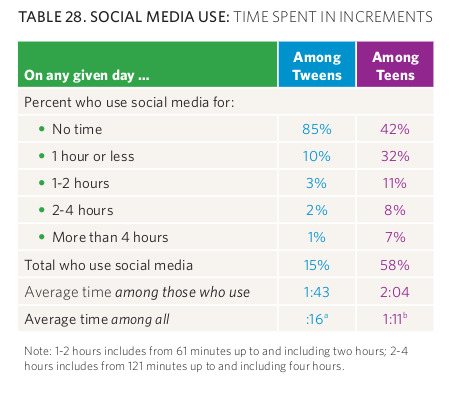Social Media Time circa 2015 (Haidt's After Babel)
Evidence indicates that most girls spent far less time on Instagram and Facebook during the previous decade than Haidt has presumed.
We previously saw that Jonathan Haidt believes that the time spent by girls on Facebook and Instagram has reached enormous heights by 2015, with the latter in particular portrayed by Haidt as a site on which 12-year-old girls spent 5 hours daily (Social Media and Time Displacement). [Note: see also Haidt’s comment below and my reply to him.]
If girls dedicated such large amounts of time to Instagram and Facebook, then these platforms could be the primary culprits in the displacement of beneficial ‘real life’ activities offline, which in turn could explain why depression among girls started to rise (at least per Haidt).
Will now look at data that contradicts the notion that most girls, at any particular age, were spending many hours daily on Facebook and Instagram.
The Common Sense Census of 2015
In early 2015, a survey of more than 2,600 youths aged 8 to 18, titled MEDIA USE BY TWEENS AND TEENS, included questions related to “social media such as Facebook, Twitter or Instagram” — a specification that fits the emphases Haidt has placed on Instagram and Facebook in his discussions of social media use by girls.
The survey split youth into two groups: Tweens (8-12) and Teens (13-18) and found that the average daily time spent on social media was 26 minutes for Tween girls (6 minutes for boys) and 92 minutes by Teen girls (52 minutes for boys). No median times were given, but the report did include a table grouped by time, albeit for girls and boys combined:
If we take into account the higher time averages among girls, it is still clear that most teen girls spent no more than an hour daily on social media — and that such usage was very rare (<10%) among younger girls.
Time Displacement
It seems unlikely that social media like Facebook and Instagram were a major causes of ‘real life’ activities displacement during the past decade for most girls, although this may be true for a substantial minority of girls (perhaps as much as one quarter during their mid teens).
We will see in a follow up article that playing computer games and watching entertainment are far more credible candidates for major time displacement.
Conclusion
Most girls did not spend more than an hour daily on social media like Facebook and Instagram around 2015, even at ages of peak usage (likely around 14-15 years old).
Notes:
Games and Videos
Facebook usage may have included playing games and viewing videos — activities that are not at all unique to social media. Furthermore, many kids may have counted YouTube as social media, since it allows users to create a profile and then publish content and interact with other users. The Common Sense survey did mention YouTube in a question about online videos, but the social media question preceded the one about videos.
UK Study
Haidt might point to a UK study where over 4 in 10 girls reported 3 or more hours daily spent on social networking (see Social Media Use and Adolescent Mental Health: Findings From the UK Millennium Cohort Study). This survey, however, included time spent on private communications and its question explicitly mentioned WhatsApp, a messaging app popular in Europe. This is like counting the time Haidt spends writing and reading emails — it’s not what is usually meant by social media, especially when the category is de facto equated, for girls at least, with Facebook and Instagram usage, as Haidt has done.
Subjective Time
Haidt might object that he is also counting thinking about Twitter or taking and editing selfies, but one advantage of self-reports is precisely that such activities are likely to be included in time estimates of usage (which is why such estimates tend to be higher than digital measures of physical interaction with screens). BTW, how often does Haidt think a typical girl uploads a new selfie on Instagram?
The Mean and The Median
Note that social media usage time for teen girls had a substantially higher mean compared to the median. This is because a substantial minority of girls did spend high amounts of time on social media. This of course may have had an impact on their mental health (or not, if it actually helped them to cope with ongoing depression and anxiety).
Correction Aug 12: I gave social media use by boys incorrectly as 71 minutes (the mean for boys and girls combined), when it should have been only 52 minutes (corrected).





People spend around 40% of their time online in 2023. With Generative A.I. making more immersive products and better games, how high do you suppose it will be in 2033?
It begins to become de-humanizing when we are raised by A.I., instead of parents, peers, communities and people.
Hi David, I don't think i ever asserted that the avg use of SM was 5 hours a day for anyone, especially for a pre-teen. I think used 5 hours when talking about a hypothetical example of a heavy user, whose friends are also heavy users. And i did mean to including thinking time and photo-taking and editing time; not just time actually on the app. I will moderate my claims and state them more clearly. I think you're also right that i need to talk more about all the other online activities that displace more time than social media. thanks for pushing me to refine my claims and state them more clearly.